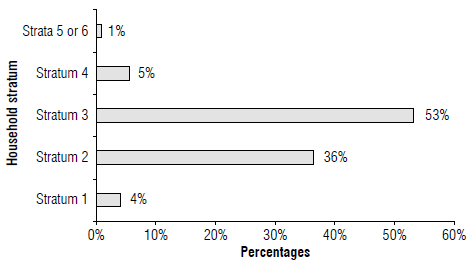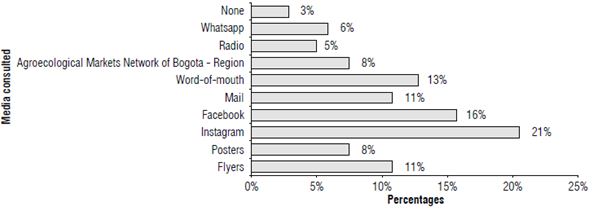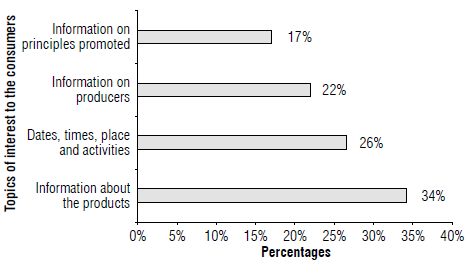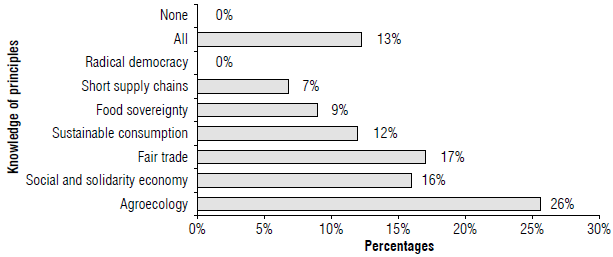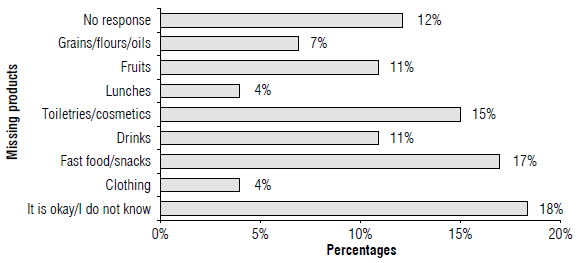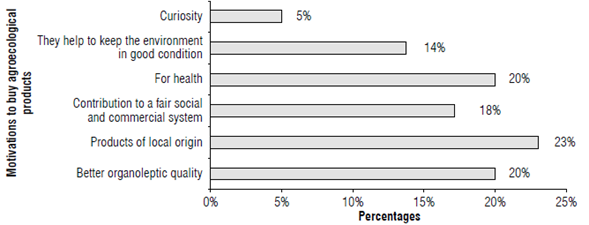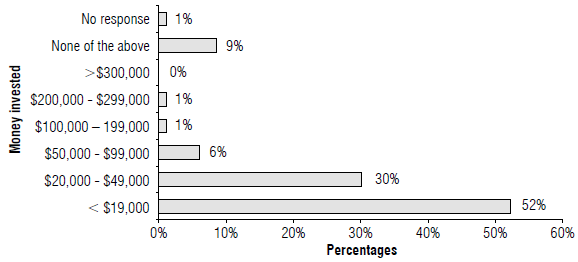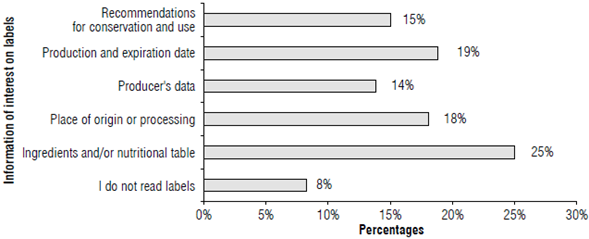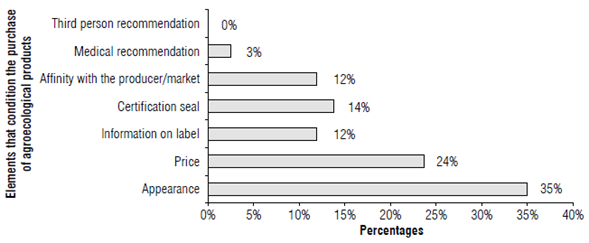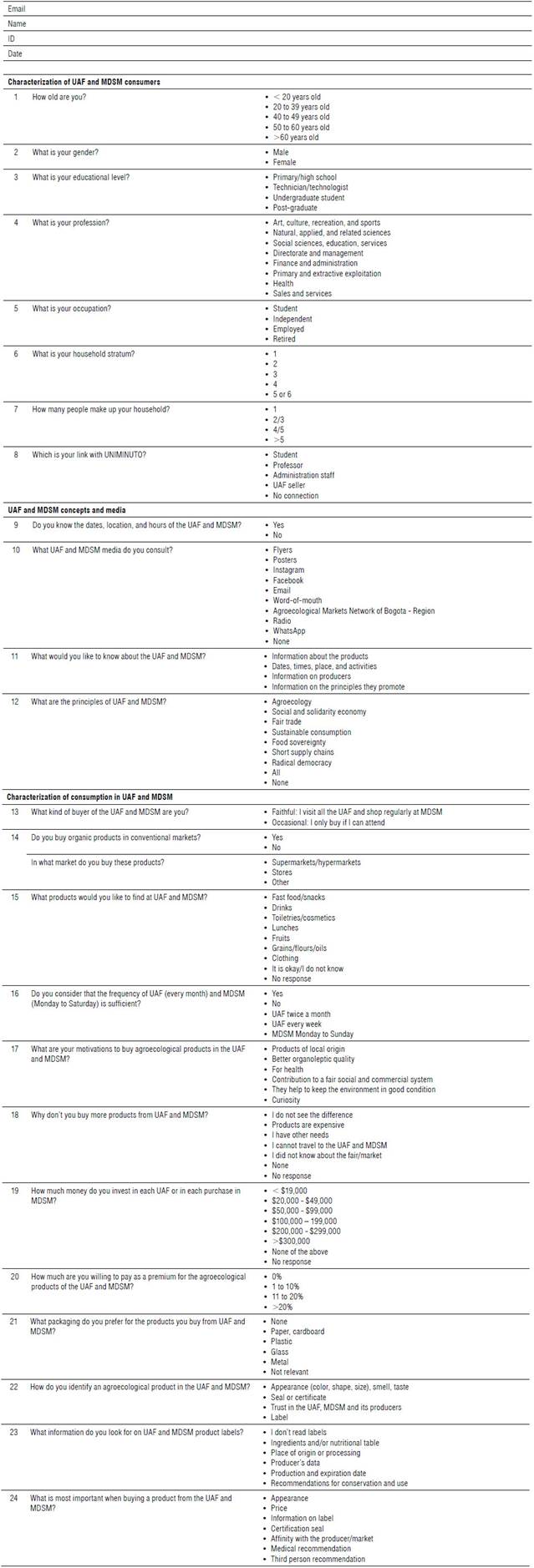Introduction
Agroecological markets are formally or informally established organizations made up of producers, consumers and/or promoters, who seek the sustainability of agri-food systems and society in general. Such sustainability may be achieved through the distribution of agroecological products in various short marketing circuits: farms, fairs, home markets, and shops. The main characteristic of these markets is their alternative rationality focused on strong economic, social, environmental, and political sustain-ability of traditional markets (Chaparro-Africano, 2019). Some types of agroecological markets are fairs, home delivery, and stores.
The UNIMINUTO Agroecological Fair (UAF) of Colombia was officially introduced in 2012 with the pedagogical objective of providing a learning environment for students of the Agroecological Engineering program as well as for students of other programs and the public. The UAF seeks to generate new knowledge and offer a space that contributes to the well-being of the UNIMINUTO community and the city of Bogota, which, in turn, offer an alternative of economic inclusion for agroecological producers. The Minuto de Dios Solidarity Market (MDSM) emerged as a complement to UAF in 2018 and works as a point of sale and home delivery service between Mondays and Saturdays of each week.
A framework of sustainability indicators was designed in 2016 to manage the sustainability of UAF and other agro-ecological markets of the Agroecological Markets Network of Bogota - Region (AMNBR). The framework includes four sustainability attributes (productivity, stability, resilience and reliability, equity, and autonomy) and twelve indicators: sales per producer, income/cost ratio of the market, producers, consumers, frequency, local market, agroecological production, distribution of benefits, prices, participation, financing, and pedagogy (Chaparro-Africano, 2019).
Some of the UAF's main shortcomings in 2018, according to the evaluation of sustainability indicators, were the number of consumers per fair (359) and total sales ($26,449,600 Colombian pesos (COP) annually, with an average per producer/day of $132,248 COP and consumer/ day of $9,209 COP) which show few consumers (of 1,377 visitors on average only 359 are consumers, 26%), and few sales per producer and consumer. The same occurs in other agroecological markets (Chaparro-Africano, 2019), including the MDSM.
Previous research determined that Colombian consumers did not yet recognize the benefits of organic products, although there is no equivalent information on agro-ecological products, so it is relevant to identify the consumer profile and the elements that influence purchases (Sánchez Castañeda, 2017) to draw up sustainable marketing (Kamiński, 2016) that allows progress in the scaling of agroecology.
Sustainable marketing emerged to protect the environment and promote responsible economic and social development. It was preceded by green marketing in the 1970s that focused on pollution and depletion of natural resources, and environmental marketing in the 1980s that focused on the development of "clean" technologies (Hunt, 2011).
Since it was not possible to identify any studies that develop the concept of sustainable marketing in agroecology, the authors propose sustainable marketing to be understood as the set of actions necessary to ensure that a product reaches those who need it. This process must be carried out while ensuring the sustainability of production and use/consumption of the product, negotiation of fair prices, and ethical promotion, sale and distribution mechanisms that do not promote consumerism.
For the UAF and MDSM, an agroecological product is a fresh, processed food, personal care, medicinal, or cosmetic product manufactured without the use of chemical synthesis and external inputs harmful to human or environmental health. An agroecological product promotes the resilience of the system through the conservation of common goods (soil, water, biodiversity, air), so that the sustainability of the agroecosystem can be ensured. This way, agroecological products link the environmental, social, and economic dimensions of production considering people, their culture, and their ancestral and new knowledge. They also focus on processes rather than inputs to avoid dependencies and promote the general welfare of both producing and consuming families (Chaparro-Africano & Naranjo, 2020).
Agroecological products, the production systems from which they are obtained, and the markets in which they are exchanged focus on the pursuit of strong sustainability, which refers to the promotion of social welfare while common goods are preserved. Strong sustainability proposes increasing the efficiency of resource consumption so that the use of resources does not exceed their regeneration capacity, and production of waste does not exceed the environment's assimilation capacity. Additionally, non-renewable resources are exploited at a rate equal to the creation of renewable substitutes (Daly, 1991).
To advance towards strong sustainability, the UAF and MDSM promote backward agroecological production and forward sustainable consumption through actions of resistance, cooperation, and social mobilization (Chaparro Africano & Calle Collado, 2017). Sustainable consumption reduces the negative impacts and increases the positive effects of consumption, with these two aspects having a strong ethical component (Hinton & Goodman, 2010). From this perspective, consumption is not positive or negative per se.
Additionally, organic/ecological/biological production and agroecological production are understood as different processes. According to the Ministry of Agriculture and Rural Development of Colombia (MADR), an organic agricultural, aquaculture or fisheries production system conserves biodiversity and the biological cycles of ecosystems, excluding synthetic inputs and reducing external inputs (MADR, 2006). Agroecology proposes that this ecological management of common goods occurs through collective action, not only in the production phase but also in the alternative circulation (Sevilla Guzmán, 2006) and consumption phases (Calle Collado et al., 2013). Therefore, the proposal for the sustainability of organic production falls short, becoming a conventional (Darnhofer et al., 2010; González de Molina et al., 2017) and unfair system (Kroger & Schäfer, 2014).
Regarding market research, the study of supply and demand began after the World War ll, when initially and due to shortages, many goods were sold out. However, supply gradually increased, and market research was needed to reduce uncertainty and guide production decisions. A market study can be general or specific, aiming to understand the supply and demand status of a product or sector in each context as well as its trends to achieve effective and efficient management. With the emergence of information and communication technologies, in addition to globalization, companies have invested more in market studies, and methodologies were refined (Dos Santos, 2017). While market studies are fallible because reality is complex, marketing based on market research has helped to achieve well-being (Lim, 2015).
In the 1970s and 1980s, the social and environmental consequences of marketing were questioned. Marketing was blamed for hyper-risk (Beck, 1992), hyper-reality and related psychological problems (Baudrillard, 1998), the promotion of a consumerist and materialistic society, and the use of resources in an unsustainable and unethical way (Alexander et al., 2011). This scenario led to a debate in the critical discipline of marketing (McDonagh & Prothero, 2014), resulting in the emergence of Societal Marketing, Ecological Marketing, Green Marketing, Environmental Marketing, and Sustainable Marketing (Kamiński, 2016). This allowed agroecology to rely on evolved marketing, avoiding repeating the mistakes of the past.
Almost all the studies identified by researchers that characterize consumers and consumption focus on organic products. A few of them focus on green products (Arroyave, 2015; Escobar-Moreno et al., 2015; Vargas Restrepo & Valencia Bitar, 2015) and only one on agroecological products (Prada, 2017).
Some studies have been dedicated to assigning all participants evaluated into a category of greater or less radicality regarding sustainable consumption: effective, potential and/or non-potential consumers (Andrade Ortiz & Flores, 2008; Henryks et al., 2014; Arroyave, 2015). Others have been focused on a particular product category (vegetables) (Díaz Pinilla, 2012) or on a single marketing aspect (price) (Rödiger & Hamm, 2015).
Most studies sought to identify the consumer by including the knowledge of characterized concepts, their preferences and/or market variables (Higuchi, 2015; Muhammad et al., 2016; Vietoris et al., 2016; Kranjac et al., 2017; Krishna & Balasubramanian, 2018), while others focused only on the market (Henryks et al., 2014).
These studies were conducted in Colombia, Ecuador, Argentina, Mexico, Canada, Australia, Peru, Spain, Serbia, India, United Arab Emirates, and Romania. The most widely applied data collection methods were surveys, followed by interviews and other methodologies such as focus groups and review of other research studies. This review of the state of the art evidences the lack of information on consumers and consumption of agroecological products in Colombia and the world.
In this context of lack of knowledge and unsustainability of some agroecological markets, this research aimed to characterize the consumer and the consumption of agro-ecological products in UAF and MDSM, to understand the consumer's motivations and limitations and extract elements that allow promoting sustainable consumption and agroecology. The research questions this study sought to answer were: what is the consumer's profile? what are their perceptions of agroecological products? and what are the processes of promotion, sale, and distribution of the evaluated agroecological markets?
Materials and methods
This study consisted of descriptive mixed (quantitative and qualitative) research (Hernández-Sampieri & Mendoza Torres, 2018). Primary information was collected in the second half of 2019 through a face-to-face and Google-formatted survey of consumers of agroecological products from UAF and MDSM, before, during, or after the purchase process.
The population corresponded to UAF and MDSM consumers. The sample contained 146 consumers, with a reliability level of 90% and a maximum error level of 5%. The sampling was accidental, not probabilistic.
The survey included 24 questions: eight to characterize consumers, four to evaluate concepts and media, and 12 to characterize consumption in UAF and MDSM (Supplementary material 1). The questions were designed to build a consumer profile and evaluate the perception of the agroecological product and of the processes of promotion, sale, and distribution of the evaluated agroecological markets. The survey was applied between September and October 2019.
The analysis of the results was based on descriptive statistics supported by Excel spreadsheets to calculate and plot frequencies, and comparison with other results reported in the literature. No discrimination was made between reports of agroecological, green, or organic products since no studies were found on the consumption of agroecological products.
Results and discussion
Characterization of UAF and MDSM consumers
Age of participants
The ages of the participants were classified into five groups, following the methodology of Martin Ruiz (2005): young people (<20 years), young adults (20 and 39 years), middle aged adults (40 and 49 years), mature adults (50 and 60 years) and elderly adults (>60 years), as shown in Figure 1:
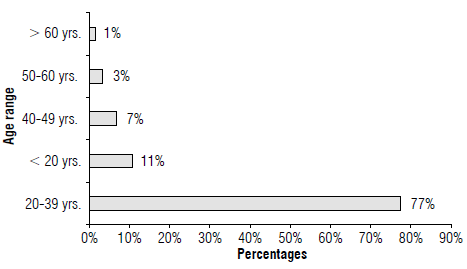
FIGURE 1 Ages of consumers at the UNIMINUTO Agroecological Fair (UAF) and Minuto de Dios Solidarity Market (MDSM).
Most of the surveyed consumers were students (61%), who made up the young people segment and, partially, the young adult age segment (UNIMINUTO, 2020). These results can also be explained because young and middle-aged adults have grown up in the period of development of organic production in Colombia, which, according to Sánchez (2017), started in 1980. The results show a similar population to that in a study conducted in several agroecological markets in Colombia, where most buyers were older than 30 years (Prada, 2017); Escobar-Moreno et al. (2015) also report an average of 30-40 years for the "green" consumer in Antioquia (Colombia).
Genders
Fifty two percent of the agroecological consumers were female and 48% male, paralleling that of gender in students: 53% women and 47% men (UNIMINUTO, 2020). This proportion differs from the "green" consumers reported by Escobar-Moreno et al. (2015) in Bogota, where 80% were women. Similar results were obtained in Norway, where 68% of organic consumers were women (Storstad & Bjørkhaug, 2003) and Serbia, where 42.7% were women (Kranjac et al., 2017).
This higher proportion of female buyers in the markets evaluated is because in Colombia, as in other countries, women spend more time doing the household shopping (Puente & Dakduk, 2011). Moreover, since the beginning of ecofeminism, more actions of environmental protection have been started by women than by men (Hosseinnezhad, 2017).
Academic level
The results in Figure 2 reflect that the study was carried out in two university markets. In comparison, a study in Mexico (Pérez-Vázquez et al., 2012) reports a lower educational level for consumers in organic markets: 45% indicated having a primary or high school diploma, 50% have a university degree and 5% a graduate degree.
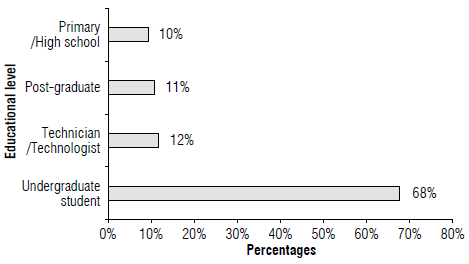
FIGURE 2 Educational level of consumers at the UNIMINUTO Agroecological Fair (UAF) and Minuto de Dios Solidarity Market (MDSM).
According to studies in Norway (Storstad & Bjørkhaug, 2003), Colombia (Arroyave, 2015; Vargas Restrepo & Valencia Bitar, 2015; Prada, 2017), United Arab Emirates (Muhammad et al., 2016), and Serbia (Kranjac et al., 2017), most consumers of organic products have a university education degree or higher.
Consumers of agroecological products, especially those with a higher academic level, are presumed to have received environmental education or better-quality education. According to Maldonado Hernández et al. (2007), education is the main explanatory variable of organic consumer behavior, especially in aspects such as human-nature orientation, ecological knowledge, perceived control, personal consequences, and environmental consequences.
Profession
Responses regarding the professions of participants were divided into eight categories (SENA, 2017), as shown in Figure 3.
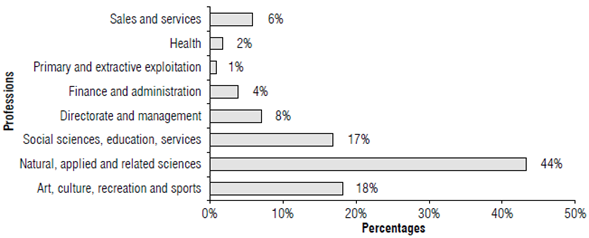
FIGURE 3 Professions of consumers at the UNIMINUTO Agroecological Fair (UAF) and Minuto de Dios Solidarity Market (MDSM)
The increased participation of the natural sciences in the results is likely because the two agroecological markets evaluated are coordinated by the agroecological engineering program, the only academic program in natural sciences at UNIMINUTO. These results differ from studies conducted in Mexico (Pérez-Vázquez et al., 2012), where consumers belonged to the following categories: administration (13%), biology or natural sciences (8%), communication (7%), pedagogy (6%) and other programs such as psychology, music, education, marketing, and systems with 3%.
Occupation
The activity to which respondents dedicate most time was considered as the current occupation. In total, 51% of the respondents were students, 32% were employed, and 18% were self-employed. These results reflect that these are university agroecological markets.
Household stratum
The household economic strata in Colombia are classified as follows: 1 and 2 are low, 3 and 4 are medium, and 5 and 6 are high strata (DANE, 2020a). Most respondents are in strata 3 and 2, due to the fact that the UAF and MDSM are in a university and neighborhood where most of professors, students, and staff belong to those strata (UNIMINUTO, 2020). This access to agroecological products by people from low and low-middle household strata agrees with the mission of the UAF and MDSM (Fig. 4).
Number of people in the consumer's household
The results in Figure 5 coincide with those reported by DANE (2020b) for Bogota households in 2018, although they differ from those reported in Argentina by Gentile and Rodriguez (2002), where half of the consumer households are made up of three people, 35% are two-person households, and 15% are single-person households.
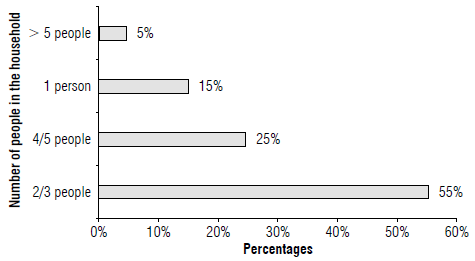
FIGURE 5 Number of people in the household of consumers at the UNIMINUTO Agroecological Fair (UAF) and Minuto de Dios Solidarity Market (MDSM).
According to Vargas Restrepo and Valencia Bitar (2015), Bogota shows higher purchasing potential in married women with children, while in Ecuador, having a child is not a determining factor for purchasing (Andrade Ortiz & Flores, 2008). According to these findings, the size of the household is not conclusive in terms of the consumption of agroecological or organic products.
Link with UNIMINUTO
The UAF takes place in the Plazoleta Verde of UNIMINU-TO's campus in Bogota on the first Thursday of each month; MDSM also has a permanent point of sale there. This explains why 83% of the consumers surveyed have links with the university (Fig. 6). People without a link to UNIMINUTO attend because both markets are open to people from the neighborhood and town; however, the low percentage maybe due to the presence of bars around the Plazoleta Verde and an MDSM point of sale.
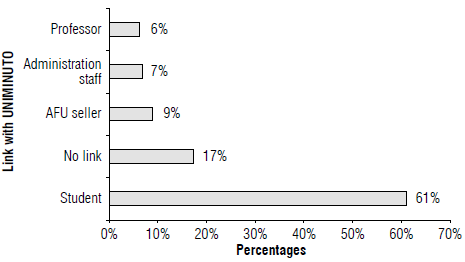
FIGURE 6 Link between consumers at the UNIMINUTO Agroecological Fair (UAF) and Minuto de Dios Solidarity Market (MDSM) and UNIMINUTO.
The difference between the proportion of those whose occupation is student (51%) and those who state that they are linked with UNIMINUTO as students (61%) maybe because not all of them consider being a student as their main occupation.
The profile of the consumer of agroecological products from UAF and MDSM, their age, gender, educational level, profession, occupation, stratum, relationship with UNIMINUTO and size of their households derive from most of the characteristics of the population that coordinates the agroecological markets evaluated or of the population of UNIMINUTO and Bogota. Some consumer characteristics, such as being young adults, women, and having a higher education, especially in natural sciences, are the most frequent in this and other similar consumer studies (Storstad & Bjørkhaug, 2003).
Knowledge of the date, location, and times of the UAF and MDSM
From the total consumers surveyed, 77% said they knew the date, location, and times of the UAF and MDSM. This result is considered low, given that to promote these two markets, posters and flyers are printed, emails are sent, and the information is disseminated in radio programs and social networks. However, every semester new students, professors, and administrative staff enter UNIMINUTO and may not receive the information. Moreover, other events are held at the same tent and on the same site, which causes confusion. Additionally, the number of emails sent and the number of events held at UNIMINUTO are very high, making effective communication difficult.
UAF and MDSM media
The media most consulted by UAF and MDSM consumers is Instagram (@feriaagroecologicauniminuto and @ mercadosolidariosminutodedios), followed by Facebook (FeriaAgroecologicaUniminuto) (Fig. 7). This is contrary to user statistics in Colombia, where in January 2019 there were nearly 32 million users on Facebook and 12 million on Instagram, with the majority women between 25 and 34 years of age (Shum, 2019). These demographic characteristics coincide with those of the respondents in this research. The preference for Instagram over Facebook may be beneficial according to other studies (Belanche et al., 2019) that found that Instagram stories increase loyalty among millennial users of both genders and non-millennial women more effectively than the Facebook wall.
Topics of interest to the UAF and MDSM
Most respondents want to know about the products (Fig. 8), which indicate that the information disseminated by producers in person and virtually by social networks is insufficient. Secondly the selection of information on dates, times, and places of the fair indicates that the promotion of the fair is insufficient, possibly due to the complexity of keeping a university population of about 18,000 people, as well as the residents of the neighborhood, well informed.
Knowledge of UAF and MDSM principles
Figure 9 shows the principles promoted by UAF and MDSM, which are intended to contribute to building sustainable agri-food systems. We expected that most consumers would identify agroecology as the main principle promoted since the name of the fair refers to it. Principles such as fair trade, social and solidarity economy, and sustainable consumption are common in the university's research and social projection work, while the little-known principles such as food sovereignty are mostly worked on only in the Agroecological Engineering program and, in some cases, in the Faculty of Communications. Finally, the principle of radical democracy is almost unknown; this maybe due to the newness of concept (Calle Collado, 2011) and to the scarce political formation of the citizenry in general. Only 13% of those surveyed recognize all the principles promoted by the UAF and MDSM, which shows a significant need for education in these areas.
Type of buyer in the UAF and MDSM
In total, 68% of respondents confirmed to be occasional buyers; most of these are students (61%) who usually do not decide on purchases for their homes. Only 32% of the respondents are loyal buyers. This shows that there is a lot of work to be done to build loyalty among buyers.
Purchase of organic products in conventional markets
The results reveal that 46% of respondents buy organic products in conventional markets (49% do not and 5% did not respond), especially supermarkets and hypermarkets, which are more convenient to households. However, many of these products are not locally produced (i.e., https://mah.com/pages/nosotrosorganicbabyfoodUKbrand and present in Colombian supermarkets) or do not use biodegradable or reusable packaging (i.e.,https://www.taeq.com. co/productos/organico organic food brand from the Éxito Group, owned by the Casino Group, France). The fact that these products are not agroecological is not recognized by consumers; this corresponds to the criticized "conventionalization" of the organic (Köger & Schäfer, 2014; González de Molina et al, 2017).
The low proportion of loyal buyers (32%) compared to a higher proportion of respondents who buy in other markets (46%) maybe because other markets offer similar products (organic), with better access alternatives (frequency, proximity, etc.).
Products missing from the UAF and MDSM
The results shown in Figure 10 are similar to those of a study carried out in Andalucia, where most consumers expressed interest in buying other products in addition to those they currently buy. However, the two studies differ in the products demanded; for Andalucia, vegetables (mainly lettuce, tomato, and onion) and fruits (mainly oranges, pears, apples) (Ipsos Insight, 2007) are the most demanded products, whereas for the UAF and MDSM fast food or snacks were the most requested products. This is explained by the fact that UAF and MDSM are university markets, and their buyers are mostly students.
UAF and MDSM frequency
Sixty six percent of respondents believed that the monthly frequency of UAF and MDSM Monday through Saturday is sufficient, while 32% said that UAF should take place twice a month, and 2% did not respond. These results may be caused by the fact that since May 2018, MDSM supplemented the UAF that takes place only eight months a year. The approval of the frequency of MDSM is because most consumers are not in the neighborhood on Sundays, making it unnecessary to open the market on this day.
Motivations to buy agroecological products
These results show equal evaluations for local production, organoleptic characteristics, health, and contribution to a social system and fairer trade (Fig. 11). The results differ somewhat from the findings of other research also in Bogota, where the main motivation for purchasing was health (23% medical recommendation) (Vargas Restrepo & Valencia Bitar, 2015). Similar results are also reported in Spain (Ipsos Insight, 2007), Argentina (Gentile & Rodriguez, 2002), Serbia (Kranjac et al., 2017), and India (Krishna & Balasubramanian, 2018). More people are aware of the negative impacts of conventional foods on their health as these effects are discovered and recognized. Consequently, they choose to consume organic foods, as reported by Raigón Jiménez (2008) which are healthier because they do not receive insecticides, herbicides, synthetic fertilizers, and additives (in the case of processed products) and contain more nutrients. Additionally, organic foods are of better quality in terms of vitamins, minerals, antioxidants, proteins, and fats. However, there maybe some confusion among consumers regarding these products. According to Higuchi (2015), more than half of all organic consumers in the world believe that natural products are organic; therefore, consumer education remains necessary.
The difference in consumer motivations found in this study with that of other studies may be that most respondents are young adults (77%) and students (61%) who, therefore, may not suffer from serious illnesses or may not be aware of the social injustice experienced by the peasants, especially as they belong to a university focused on social projection.
Reasons not to buy more products from the UAF and MDSM
The results (Fig. 12) are the same as those reported in the study in Andalucia, in which prices were recorded as the main constraint to purchase, both for new consumers to arrive and for existing ones to remain faithful (Ipsos Insight, 2007). According to Aschemann-Witzel and Zielke (2017), price is the most significant perceived barrier to purchase and depends on the role that the consumer plays at the time of the purchase. A positive role means that the higher price is a sign of quality, and a negative role indicates that a sacrifice must be made to acquire the product. A person's income defines the role; if their income is low, the consumer takes a negative role, and if their income is high, the product gains a positive role, which was expected given the consumer's stratum of the UAF and MDSM. However, checking if the sale prices of some agroecological products can be corrected is not ruled out (Chaparro-Africano & Salazar Soto, 2020).
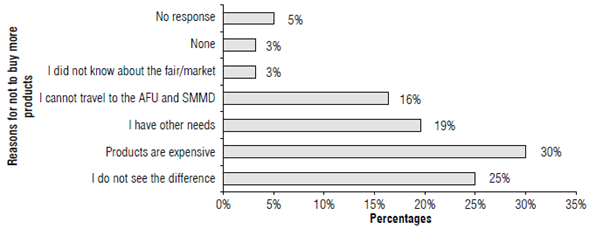
FIGURE 12 Reasons for not to buy more products from the UNIMINUTO Agroecological Fair (UAF) and Minuto de Dios Solidarity Market (MDSM).
The second most frequent response (25% do not see the difference between one agroecological product and another) suggests that the positive role is achieved if there is better education, communication, and marketing of agroecological products.
Education also helps buyers to better understand the prices of agro-ecological products, an aspect of great relevance highlighted by other authors (Rödiger & Hamm, 2015).
Although price was the most frequent response possibly because most respondents are low- or middle-income students, it did not obtain an overwhelming proportion, possibly because most respondents have university training, especially in natural sciences, that allows them to value rural agricultural work more.
Price is also the most important criterion when buying any food in Colombia (El Tiempo, 2019), although it is combined with criteria such as the appearance at the time of the purchase (Henryks et al, 2014). Therefore, these findings must be analyzed with an integrative approach.
Money invested in UAF and MDSM purchases
The little money invested in each purchase of agroecological products (Fig. 13) may be due to the low purchasing power of most respondents (89% of strata 2 and 3). Most of those respondents do not shop from home (61% are students) and do not make important purchases to avoid carrying packages over long distances. This result is decisive from the geomarketing theory, according to which buyers acquire products at the point of sale closest to their homes (Ramadani et al, 2018), although for UNIMINUTO it is crucial to offer agroecological products to the middle and lower strata of the city.
Willingness to pay extra
We found that 63% of the consumers are willing to pay up to 10% premium, 24% would accept between 11 and 20%, 9% of the customers would pay 0%, 2% would pay over 20% and 2% did not respond. This result (89% willing to pay extra) differs slightly from data reported in Figure 12, where 55% considered the products expensive or did not know the differences compared to non-agricultural products. These findings suggest that the respondents recognize a superior quality in agroecological products (Fig. 11) but do not have greater purchasing power, or require more information about their benefits.
The results in this study are like those reported in Spain (Ipsos Insight, 2007), Bogota (Vargas Restrepo & Valencia Bitar, 2015), and Romania (Vietoris et al, 2016), where the highest percentage of respondents were willing to pay 10% premium. However, in Serbia this premium increases to 20%, (Kranjac et al, 2017). Escobar-Moreno et al. (2015) also report that only 10% would not be willing to pay a premium in a study carried out in Antioquia.
Packaging preferred by respondents in UAF and MDSM
Eighty percent of respondents prefer biodegradable packaging, reusable packaging such as glass, or no packaging (Fig. 14), reflecting their interest to the environment. These results coincide with other studies (Orzan et al, 2018), since these preferences will be maintained if the product's final price responds to the quality demanded by the consumer.
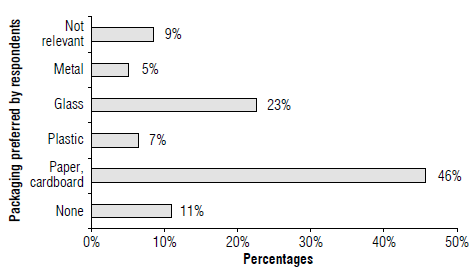
FIGURE 14 Packaging preferred by respondents at the UNIMINUTO Agroecological Fair (UAF) and Minuto de Dios Solidarity Market (MDSM).
The UAF and the MDSM replaced plastic packaging with biodegradable or reusable packaging and have done reverse logistics of reusable packaging since 2012. These practices were implemented well before the issuance of Resolution 1407 of 2018 by the Ministry of the Environment and Sustainable Development that encourages the use, innovation and eco-design of packaging placed on the market (Ministerio de Ambiente y Desarrollo Sostenible, 2018).
Identification of agroecological products
Thirty four percent of respondents identified agroecological products by appearance, 29% by the seal or certificate, 23% based on their trust in the UAF and its producers, and 14% by the label. The proportion of respondents who believe that they can identify an agroecological product by its appearance is surprising since this does not depend only on its agroecological quality but also on elements related to the variety, irrigation, crop or animal nutrition, and processing (Raigón Jiménez, 2008). According to Gentile and Rodriguez (2002), most consumers (60%) identify an organic product by the brand, the certification seal, and/ or the label, while the remaining 40% based on their trust in the producer.
The trust generated by the UAF and MDSM, their seal, their product labels, and their producers is positive (23% respondents). However, the results also evidenced that consumers have little knowledge of the Participatory Guarantee System (PGS) of the AMNBR (Chaparro-Africano & Naranjo, 2020), a mechanism recognized by the MADR through Resolution 464 of 2017 (MADR, 2017) that seeks to overcome multiple deficiencies of third-party certification such as cost, the non-participation of those who produce, distribute, and consume the products, and its lack of adaptation to the needs of agroecological production. Low consumer recognition of PGS was also reported by other authors (Hamzaoui Essoussi & Zahaf, 2008). This should be corrected as it reinforces the prior information received by consumers.
Regarding the organic seal, in Colombia the legislation includes Resolution 0148/2004 (MADR, 2004), Resolution 00036/2007 that modifies Resolution 0148 (MADR, 2007), Resolution 187/2006 about organic production (MADR, 2006) and its regulation, and Resolution 199/2016 that modifies Resolution 199 (MADR, 2016). Altogether, these resolutions determined that organic products should be identified as such by the seal issued by the respective certifier, and the organic food seal of the MADR.
Information of interest on labels
The results about information of interest on labels (Fig. 15) differ from those of the National Institute of Health, where only 28% of respondents read the labels, 39% read the nutritional table and 33% the ingredients, versus 82% of respondents who read labels according to this study. These last two elements (nutritional table and ingredients) are the third and fourth criteria to be considered when buying food, only after the price and brand (El Tiempo, 2019).
Many people do not read labels due to lack of time, small print size and technical language (El Tiempo, 2019). For this reason, the UAF as a producer market invests time in disseminating this information and supports a proposal to renew labels (Semana, 2019).
Elements that affect the purchase of agroecological products in the UAF and MDSM Product appearance is always a determining indicator for consumers of organic products (Henryks et al., 2014). This result was also observed in this (Fig. 16) and other studies (Rojas Ramírez & Cuéllar Rojas, 2014). For this reason, the appearance of the product should reinforce the positive consumer perception of agroecological products and is, therefore, no less important than safety, superior nutritional content, or fair price.
Conclusions
The profile of consumers of agroecological products from the two university agroecological markets evaluated and the characteristics of their consumption are closely related to the surveyed population, who are mostly university students from middle and lower strata; however, age, gender, and educational level are common features with similar studies.
Most UAF and MDSM consumers are occasional because these markets do not meet their expectations regarding the type of product (many hope to find fast food and agroecological snacks), the frequency of the UAF (many prefer a fortnightly frequency), and prices (products are perceived as expensive due to low purchasing power of consumers). This is observed because of better alternatives regarding location, frequency, hours, etc. offered by conventional markets, insufficient information campaign, and the consumer's profile.
The motivations for the purchase of agroecological products combine aspects of collective well-being such as local production and the contribution to a fairer socioeconomic system. They also include aspects related to individual well-being such as health and organoleptic characteristics of the products. These motivations cover socioeconomic but not environmental aspects, which was an unexpected finding.
The main limitation for the purchase of agroecological products is appearance and the second is price. Therefore, if the appearance were improved, consumers would recognize pricing as fairer. This highlights the need to simultaneously improve the appearance of the products by producers and education by markets.
Additionally, the main limitation for not buying more agroecological products is pricing, which seems to be contradictory since there is a great willingness to pay some premium. Consumers consider that the pricing of the products is fair, but they may not have enough purchasing power or require more information to avoid perceiving the negative side of prices.
The educational effort of these university agroecological markets (UAF and MDSM) is insufficient. Consumers do not know the difference between agroecological products and other kinds of products, think that an agroecological product can be recognized only by its appearance, do not understand the role of participatory certification, and directly express interest in knowing more about the markets, products, producers, and principles promoted by UAF and MDSM. Despite this, the large proportion of respondents who read the labels can be considered a great educational achievement of the UAF and MDSM.













